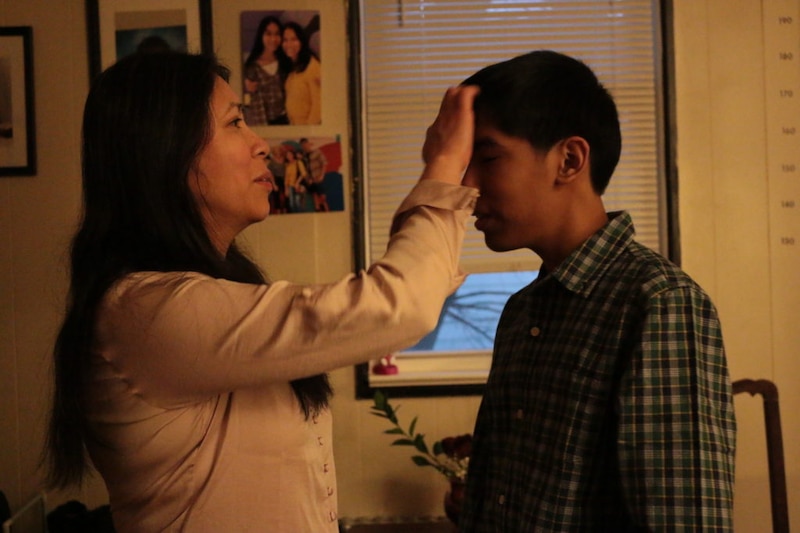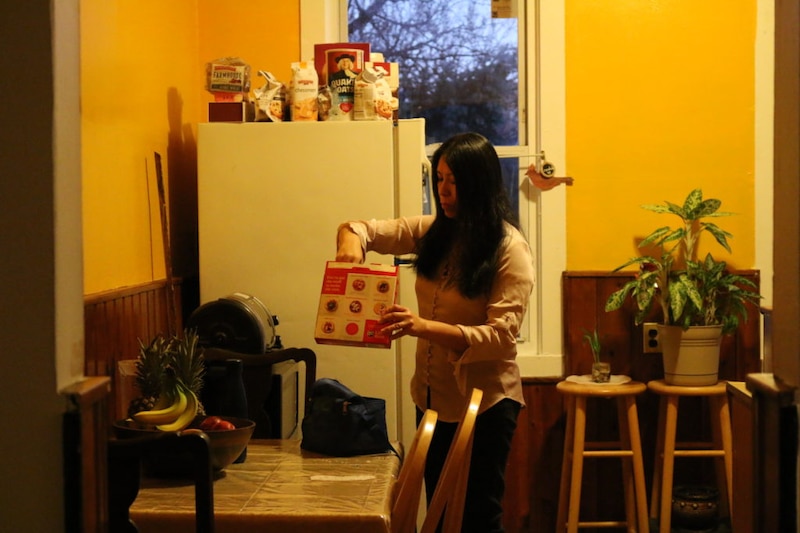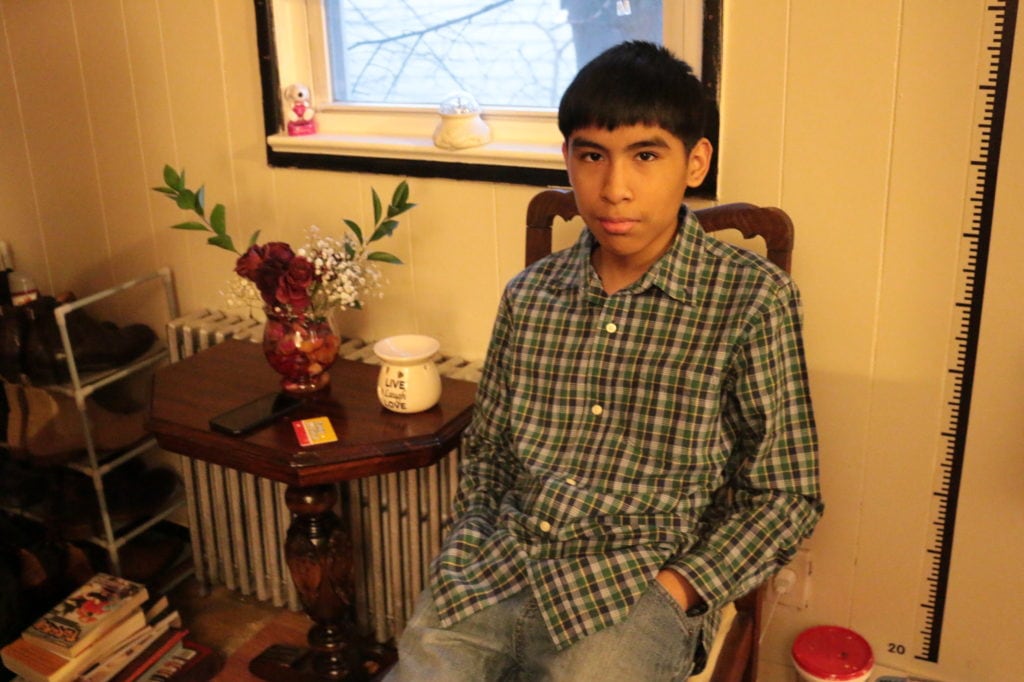After years of searching in vain for the right school for her son, Erendira Matamoros was hopeful she found a good fit.
David, a 14-year-old who is autistic and primarily speaks Spanish, is legally entitled to a small special education classroom led by a bilingual teacher, but that’s hard to come by in New York City. Only about a third of the roughly 5,500 students who required small bilingual special education classrooms this fall were placed in such settings.
After attending three different schools over the past three years, David was admitted this January to a high school program for children with autism. The program is not bilingual, so David was paired with a paraprofessional serving as a translator. The arrangement isn’t optimal — many nights he still needed help translating his homework — but his mother was hoping David would thrive there.
Now, as the coronavirus has shuttered school buildings across the city, David is readjusting once again. For the first month of remote learning, David went without a translator, and even now, his translator isn’t available every day.
“After so many changes for him, all the schools, I think he was feeling more comfortable with the teachers and the classrooms — he was starting to have an environment,” Matamoros said. “Then everything already changed again for him.”
Students with disabilities who are learning English have long been among the most vulnerable in the city. As of November 2019, about 3,800 students legally entitled to be in small, bilingual special education classes didn’t receive the accommodation, according to education officials.
There is no easy fix, and the educational crisis brought on by coronavirus has only underscored that these students are at an extreme disadvantage.
Under state regulations, districts must ensure that English language learners with disabilities are receiving the services outlined in their individualized education plans, or IEPs — and schools must consider their special language needs. Nothing “can, or should, replace” a student’s access to bilingual or other language programs because staff isn’t available or because of scheduling conflicts.
But that isn’t the reality for many students. It’s difficult enough for the district to hire bilingual teachers. It’s even harder to find bilingual teachers with a special education background, often due to the cost and extra work required for the certifications, advocates say. Also, students who speak the same language and have similar special education needs are rarely in the same school buildings, making it tough to group them into classes. For example, half of the students who needed Spanish-language special education services in the 2017-18 school year were the only students in their schools who did so, the department said.
Since 2016, New York City has been on a state corrective action plan, ordering the education department to better serve students who are learning English. But according to documents obtained by Chalkbeat through the Freedom of Information Law, the city failed to meet the deadline for certain benchmarks of the plan last school year, prompting the state to give the city an extension.
Under the plan, which asks the city to improve myriad services for English language learners, the state ordered the city to ensure that all students like David receive their entitled services by next school year — a goal that is likely to remain unmet.
Danielle Filson, a spokesperson with the education department, said education officials have connected more children with the proper services in the last few years, but they “recognize there is work to do.”
The state recently approved a special mixed class structure for New York City, where monolingual and bilingual special education students are taught together by certified bilingual and special education teachers, so that schools can form more classes, city officials said. Schools started implementing that in September.
“We’re committed to meeting the needs of English Language Learners with disabilities, and in order to expand opportunities we’ve developed a new, specific class model and are working with the State on teacher certifications,” Filson wrote in a statement.
In the meantime, in lieu of a bilingual special education teacher, students are often paired with a paraprofessional, who speaks the child’s native language and supports them in class by translating coursework and lessons, according to the education department.
But bilingual education is “not about translating from one language to the other,” said Tamara Alsace, a past president of the New York State Association of Bilingual Educators, who oversaw multilingual students at Buffalo public schools for a decade. Translation can be a “turn-off” for students, and often doesn’t help them understand the concept of what’s being taught unless the paraprofessional is familiar with the subject area, she said.
“These are not new issues; they’ve been around for a long time,” Alsace said. “Unless we think of long-term solutions, we are not going to resolve them.”
Uphill battle
Finding the right special education services can be daunting for any family, but it’s even more challenging for non-English speaking parents, advocates say. Many may not be aware of all their rights, such as asking for a translated version of their child’s IEP.
“All this burden is on the parents to navigate such a complex system,” said Paola Jordan, co-director of the Metropolitan Parent Center at Singeria, an organization that helps Spanish-speaking families navigate the special education system. “It is a complex problem that needs a complex solution.”
Finding support for David has been an uphill battle for Matamoros since her son moved into her Queens apartment in 2017, after living with his grandmother in Mexico while Matamoros worked to support two other sons. She took days off of work to research good programs for David and attend workshops that taught her about the city’s special education system.

In some ways, Matamoros had an advantage over some parents of English language learners since she’s been in the U.S. for longer than her son and is comfortable speaking English.
After enrolling David at a middle school in Maspeth, where they live, school officials evaluated David and classified him as being on the autism spectrum. They determined he should be in a bilingual class serving no more than a dozen students with similar needs. Because they couldn’t provide those services, he was paired with a paraprofessional who translated lessons for him.
“He was feeling very intimidated with the new language, and he only wanted to speak Spanish,” Matamoros said.
His mother was also intimidated, having to figure out how to meet the needs of her son, who she hadn’t lived with for the past decade. She would spend her mornings before work on the phone and searching the internet for support services, winding her way through the special education bureaucracy.
“Sometimes it’s difficult for me to do calls and following up,” Matamoros said. “It’s difficult for me to follow everything.”
The next couple years were a saga to find the right spot for David. His mother had enrolled David in a dual language middle school in Cypress Hills, but officials soon determined that he needed more intensive support than it could provide and should be in a District 75 program offering specialized programs for students with significant disabilities.
Matamoros, working with the group Advocates for Children, eventually won the right to send her son to a state-approved private school. But none of the schools she toured had bilingual services.
David ended up in a public high school in Williamsburg that was unable to provide the bilingual special education and speech therapy mandated by his IEP. The school gave Matamoros a list of providers to call, with the cost covered by the education department. Matamoros contacted nearly 40 speech therapists over several months before finding someone — a therapist who they would see once a week, about an hour away from their home, she said.
Late last year, Matamoros took one last shot at getting her son at least some of the services he needed. She applied for David to attend a Horizon program, which caters to autistic students who are on or below grade level. He was accepted to a program in January at Brooklyn Community Arts and Media High School. Again, he was paired with a paraprofessional to help translate.
David was happy with landing at a school where he’d likely stay.
“Everytime I had to change a school, I had to say goodbye to people who already I know,” David said in Spanish during an interview last month.
Now, life has been upended once more.
On top of helping David navigate online learning, Matamoros lost her fast food job and worries about keeping her family afloat financially. The mall food court where Matamoros works is temporarily closed, and she’s already one month behind on bills. She needs to find a steady stream of income by the end of April, but doing so is complicated because her son can’t be left home alone to navigate online learning.
Even before this crisis, she had to help David with his homework, often looking up YouTube videos in Spanish to understand his English or Algebra lessons. But now the demands have increased. The rupture of routine is particularly difficult for individuals with autism, who tend to struggle with flexible thinking, but can thrive with clear routines. Now David and his mom spend hours every day trying to keep up with the teen’s coursework.
“I feel like this is another full-time job because I have to sit with David, I have to see what he’s doing, what he’s learning, and then I have to basically review with him again because a lot of things have to be translated, and then make sure he is understanding,” Matamoros said.
Bilingual teaching shortage
One of the biggest hurdles to expanding bilingual special education is a shortage of certified teachers. There are currently 500 certified bilingual special education teachers in the city, according to officials, with another 500 special education teachers who have a bilingual “extension,” meaning they later became certified in the field. This still falls short of the need, including for students who speak less common languages, the education department said.
Last school year, most New York City districts that had the greatest need for these small, bilingual programs — particularly in Spanish and Chinese — also had high shares of low-income families, according to the city’s response to the state’s corrective action plan. Often, high-needs districts also have difficulty attracting and retaining teachers.
“It’s really hard to get teachers to go to those areas,” said Lori Podvesker, director of disability and education policy at INCLUDEnyc and a member of the city’s Panel for Educational Policy.
Recruiting enough qualified teachers is a huge challenge in opening new bilingual special education programs, according to advocates and the education department. Currently, there are a total 275 bilingual special education classes across all grades in New York City, a spokesperson said.
People who want to become certified in both bilingual and special education must pursue about 18 to 24 more credit hours of coursework than a general education teacher according to the city teachers union. In the end, they’re serving students who have some of the highest needs in the city.
“It’s not like they get paid extra to do that,” said Alsace, the former Buffalo educator. “They don’t get anything extra for being a bilingual special education teacher.”
Bilingual special education teachers, however, are eligible for more pay under the city’s Bronx Plan, which provides salary boosts for teachers at certain hard-to-staff schools, according to the education department.
The needle seems to be inching up in the right direction. The percentage of students with disabilities and are English language learners who are receiving the support they need has slightly improved over the past few years —34% percent of students last school year received mandated services, up from 26% two years before that.
Through a program with New York City Teaching Fellows, the city subsidizes tuition for special education teachers to get their bilingual certification. The city also helps recruit teachers and covers extra tuition costs at certain colleges for a state program called the Intensive Teacher Institute in Bilingual Special Education. The first cohort started this year with Hunter College, according to the city.
Rita Rodriguez-Engberg, director of the Immigrant Students Rights Project at Advocates for Children, believes the city and state should bolster partnerships with universities, as well as loan repayment and recruitment programs, to encourage more people to pursue bilingual special education.

The city said it could use more support from the state on recruiting more teachers for this work. The state did not respond to multiple requests for comment on this story. At a March Board of Regents meeting, Interim Commissioner Shannon Tahoe said the state is considering work groups on how to address teacher shortages in bilingualism and special education.
Advocates believe the department of education should tap outside providers to create hubs offering various therapies and support. Having after-school programs where parents could take their children to receive extra help would be one way to achieve that, said Jordan, from Singeria. Podvesker suggested creating borough-based programs where students could receive their related services, such as speech therapy. These wouldn’t close the gap for bilingual special education services and still may not work for all families, she said, but it would help some people who would instead be charged with finding services on their own, as David’s mother did with his required speech therapy.
As for David, Matamoros believes it’s too early to know if his current school will help him get on track. He has only been there for a couple months, and now he’s learning from home under challenging circumstances.
Matamoros said she admires how David never complains and adjusts to situations as best as he can. He often asks his mother why he’s had to change schools or why he has extra services. She tells him it’s so he can one day be on his own.
“You are going to have to go and work for your own living, and I’m not gonna be here all the time with you like I am now,” Matamoros said she tells David. “So you have to learn how to do everything on your own.
“So that’s my goal. That is what I’m looking for in all the services he is getting.”







